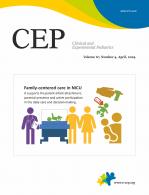To the editor,
Intrauterine growth restriction (IUGR)/small for gestational age (SGA) neonates are an important cause of neonatal morbidity and mortality. In Bangladesh, incidence of low birth weight (LBW) and IUGR-LBW are 22.6% and 16.5% respectively, which are highest among south central Asian countries [
1]. Chronic intrauterine hypoxia stimulates erythropoiesis leading to polycythemia in these IUGR neonates at the cost of loss of the iron stores to fulfill the demands of increased erythropoiesis. Iron is particularly vital for early brain growth and function and its deficiency during brain development is associated with long-term neurocognitive problems [
2]. Red cell indices are late markers of iron deficiency and may not reflect tissue iron status in the newborn infant. Serum ferritin concentration has been used as a standard measurement of iron store in neonates, children and adults. There is inconsistent neonatal iron dosing by various professional societies and our current practice is to give iron supplementation only in preterm neonates (<35 weeks of gestation). So, aim of this study was to compare the iron status and red cell parameters between healthy term SGA and term appropriate for gestational age (AGA) neonates at birth; thus, helps to make decision of giving iron supplementation in term SGA neonates.
This cross sectional study was conducted in the Department of Neonatology and Obstetric & Gynecology, Bangabandhu Sheikh Mujib Medical University (BSMMU), Dhaka from October 2018 to September 2019 after approval by Institutional Review Board of BSMMU (No. 10064(A)). Those gestational age between 37 completed to 41 weeks and expected fetal weight <4,000 g by antenatal ultrasonogram were counseled for this study. A written informed consent was taken from parents and confidentiality was assured. Just after delivery, baby was managed according to departmental protocol and umbilical cord was clamped within 30 seconds and cut. Cord blood sample was taken into 2 tubes either by milking the cord or with 5-mL syringe. Babies weight was taken at delivery room within 30 minutes of delivery without having any cloth by digital weighing machine (Baby scale BY 80, Beurer, Ulm, Germany) with variation of ±5 g. Then details of maternal and perinatal medical history and anthropometry were recorded for each neonate. All healthy term neonates (gestation 37–42 weeks) were included in this study. Whose birth weight <10th centile was defined as SGA and considered as case and those birth weight were between 10th and 90th centile defined as AGA and was taken as control. Neonates were excluded if they were large for gestational age, preterm, multiple gestation, low Apgar scores (<7) in 5th minute, gross congenital anomalies and born to mother with chronic medical illness and/or moderate to severe anemia. After clamping the umbilical cord, the 4-mL blood was taken into 2 tubes. One is ethylene diamine tetra acetic acid tube for complete blood count, which includes hemoglobin (Hb) as g/dL, packed cell volume as %, mean corpuscular volume as fl and red cell distribution width as %. Another one is plain tube for S. ferritin and iron. Red cell parameters were assessed by using fully automated blood cell counter (XN-2000 model, Sysmex, Kobe, Japan)in laboratory medicine department of BSMMU. Serum ferritin was measured as ng/ml by fully automated bidirectional interfaced chemi-luminescent immunoassay and serum iron as µg/dL by photometry method (Ci 4100 model, Architect Plus Inc,, Fort Smith, AR, USA) in Biochemistry department of BSMMU. All quantitative data were compared by using the unpaired Student t test and categorical data were compared by chi-square/Fisher exact test. Data were analyzed using IBM SPSS Statistics ver. 20.0 (IBM Co., Armonk, NY, USA). P<0.05 was considered to be significant.
Total 1,137 term deliveries were done during the study period. Among them 139 were term SGA babies. Fifty-seven cases did not fulfill eligibility criteria. Among 82 eligible cases 40 cases were included for this study by convenient sampling. Gestational age matched 40 AGA neonates were taken as control group. Baseline characteristics of the studied neonates are presented in
Table 1. No significant difference was found in maternal age, maternal hemoglobin level and gestational age between SGA and AGA groups. Significant difference was found in birth weight between 2,148.62±258.67 g of SGA babies and 3,106.00±400.06 g of AGA babies,
P<0.001. Comparison of red cells parameters and iron status between SGA and AGA neonates are shown in
Table 2. Mean hemoglobin level was significantly high in SGA group (16.63±2.48 g/dL) as compared with AGA group (14.56±1.44 g/dL),
P<0.001. Mean values of serum iron were 117.13±58.28 µg/dL in SGA babies and 153.20±39.82 µg/dL in AGA babies and
P value is significant (
P=0.002). Significantly higher serum ferritin level was found in AGA group (131.86±58.02 ng/mL) in comparison to SGA group (97.88±56.38 ng/mL),
P=0.001.
In this study mean values of red blood cell (RBC) count, and Hb were significantly higher in SGA group than AGA group. Similar results were observed by different studies [
3-
6]. Current study showed SGA neonates had significantly lower mean values of serum ferritin which were similar to the previous observations [
7-
9]. These findings signify that term SGA neonates have lesser total iron store than gestational age matched AGA neonates at birth.
In our study, mean value of serum iron was significantly low in SGA group as compared to AGA group, which was also found in previous study, though statistically not significant [
8,
9].
Single center and small sample size were the limitations of this study.
In conclusion, term SGA neonates had higher Hb, hematocrit, RBC count and mean corpuscular hemoglobin level than term AGA neonates at birth. But they are deficient in iron store indicated by lower cord blood iron and ferritin level.





 PDF Links
PDF Links PubReader
PubReader ePub Link
ePub Link PubMed
PubMed Download Citation
Download Citation


